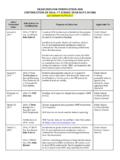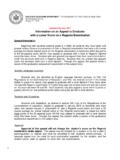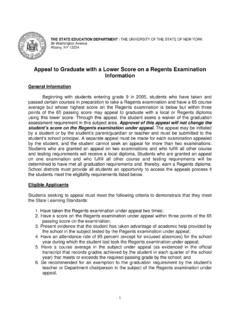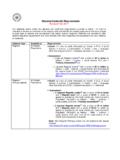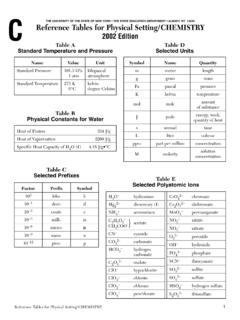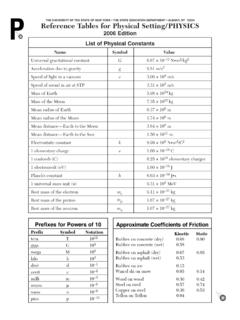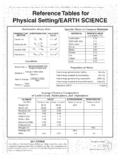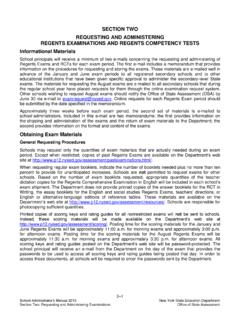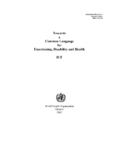Transcription of Guidance to School Districts for Creating a Safe and ...
1 THE STATE EDUCATION DEPARTMENT / THE UNIVERSITY OF THE STATE OF NEW YORK / ALBANY, NY 12234 Guidance to School Districts for Creating a Safe and Supportive School Environment For Transgender and Gender Nonconforming Students JULY 2015 Introduction The New York State Education Department ( NYSED ) is committed to providing all public School students, including transgender and gender nonconforming ( GNC ) students, with an environment free from discrimination and harassment, to fostering civility in public schools, and to ensuring that every student has equal access to educational programs and activities. The Dignity for All Students Act ( DASA ) illustrates the State s commitment to ensuring that all students are educated in a safe and supportive School New York State Education Law 3201-a prohibits discrimination based on sex with respect to admission into or inclusion in courses of instruction and athletic teams in public Furthermore, DASA specifically provides that no student shall be subjected to harassment or bullying by employees or students on School property or at a School function.
2 Nor shall any student be subjected to discrimination based on a person's actual or perceived race, color, weight, national origin, ethnic group, religion, religious practice, disability, sexual orientation, gender (including gender identity or expression), or sex by School employees or students on School property or at a School function. 3 DASA includes gender as a protected category and defines gender as a person s actual or perceived sex and includes a person s gender identity or expression. 4 Title IX of the Education Amendments of 1972 ( Title IX ) specifically prohibits discrimination on the basis of sex in federally-funded education programs and The United States Department of Education s Office for Civil Rights has issued Guidance recognizing that Title IX protects transgender students against discrimination based on their gender 1 EDUC.
3 LAW ART 2. 2 EDUC. LAW 3201-a. Some states and local governments have adopted legislation providing explicit protections for transgender students in public schools. See CAL. EDUC. CODE , MASS. GEN. L. CH. 76, 5. See also NEW YORK CITY, ADMIN. CODE 8-101 TO 8-1103, BINGHAMTON, CODE PT. I, 45, 45-A. 3 EDUC. LAW 11(7); 8 NYCRR [l][2]. 4 EDUC. LAW 11(6). For an extensive resource on the implementation of DASA, please see the New York State Education Department s (NYSED) publication: The Dignity Act, A Resource and Promising Practices Guide for School Administrators & Faculty available at 5 20 1681(a); see also 34 (a); 28 (a) 6 See 20 1681-1688 (2006); 34 Part 106 (2010); 54 Part 54 (2000); United States Department of Education, Office for Civil Rights, Questions and Answers on Title IX and Single-Sex Elementary and Secondary Classes and Extracurricular Activities (December 1, 2014)
4 , available at 1 Additionally, the Departments of Education and Justice have stated that under Title IX, discrimination based on a person s gender identity, a person s transgender status, or a person s nonconformity to sex stereotypes constitutes discrimination based on sex and asserted a significant interest in ensuring that all students, including transgender students, have the opportunity to learn in an environment free of sex discrimination in public The purpose of this Guidance is to assist School Districts in fostering an educational environment for all students that is safe and free from discrimination regardless of sex, gender identity, or expression and to facilitate compliance with local, state and federal laws concerning bullying, harassment, discrimination , and student privacy.
5 All students need a safe and supportive School environment to progress academically and developmentally. Administrators, faculty, staff, and students each play an important part in Creating and sustaining that environment. This Guidance document is intended as a resource guide to help School and district administrators continue to take proactive steps to create a culture in which transgender and GNC students feel safe, supported, and fully included, and to meet each School s obligation to provide all students with an environment free from harassment, bullying and discrimination . This Guidance is intended to be complimentary to the existing comprehensive resources made available by NYSED relating to the implementation of In order to make this document as helpful as possible, illustrative examples that highlight frequently-asked questions appear throughout in italics.
6 These scenarios and remedies are based on real-life examples from New York-based students and schools, and are not meant to be exhaustive of all potential scenarios or remedies appropriate for each School community. Definitions Understanding the common terminology associated with gender identity is important to providing a safe and supportive School environment for students. The following terms appear in this document and we present the following definitions used by research, advocacy and governmental organizations to assist in understanding the Guidance presented. Although these are the most commonly used terms, students may prefer other terms to describe their gender identity, appearance, or behavior.
7 Terminology and language describing transgender and GNC individuals can differ based on region, language, race or ethnicity, age, culture, and many other factors. Generally speaking, we recommend that School staff and educators inquire which terms students prefer; a good general guideline is to employ those terms which the students use to describe themselves. Assigned Sex at Birth: the sex designation, usually male or female, assigned to a person when they are , at 25; United States Department of Education, Office for Civil Rights, Questions and Answers on Title IX and Sexual Violence (April 29, 2014), available at , at 5. 7 Statement of Interest of the United States, Grimm v. Gloucester County School Board, Case No. 4:15cv54 ( Virg.)
8 Filed June 29, 2015), at 2, available at 8 EDUC. LAW ART. 2. 9 See GLAAD Media Reference Guide Transgender Issues, available at , Trans Student Educational Resources (TSER) Definitions, available 2 Cisgender: an adjective describing a person whose gender identity corresponds to their assigned sex at birth. Gender expression: the manner in which a person represents or expresses gender to others, often through behavior, clothing, hairstyles, activities, voice, or Gender identity: a person s gender-related identity, appearance or behavior, whether or not that gender-related identity, appearance or behavior is different from that traditionally associated with the person s physiology or assigned sex at birth.
9 Everyone has a gender Gender nonconforming (GNC): a term used to describe people whose gender expression differs from stereotypic expectations. The terms gender variant or gender atypical are also used. Gender nonconforming individuals may identify as male, female, some combination of both, or Sexual Orientation: a person s emotional and sexual attraction to other people based on the gender of the other person. Sexual orientation is not the same as gender identity. Not all transgender youth identify as gay, lesbian or bisexual, and not all gay, lesbian and bisexual youth display gender-nonconforming Transgender: an adjective describing a person whose gender identity does not correspond to their assigned sex at Transition: the process by which a person socially and/or physically aligns their gender expression more closely to their actual gender identity and away from that associated with their assigned sex at birth.
10 Understanding School Climate and Transgender Students Research indicates that transgender and GNC students are targeted with physical violence and experience a hostile School environment at an even higher rate than their Lesbian, Gay, and at ; see also Resolution Agreement Between Arcadia Unified Sch. Dist., the Dept. of Educ., and the Dept. of Justice, OCR Case No. 09-12-1020, DOJ Case No. 169-12C-70 (July 24, 2013). 10 GLSEN Model District Policy on Transgender and Gender Nonconforming Students, available at ; Massachusetts Dep t of Educ. Guidance , available at 11 Mass. Gen. Laws ch. 4, 7; Massachusetts Dep t of Educ. Guidance . 12 Massachusetts Dep t of Educ. Guidance ; see also GLSEN Model District Policy on Transgender and Gender Nonconforming Students ( A term for people whose gender expression differs from stereotypical ).
